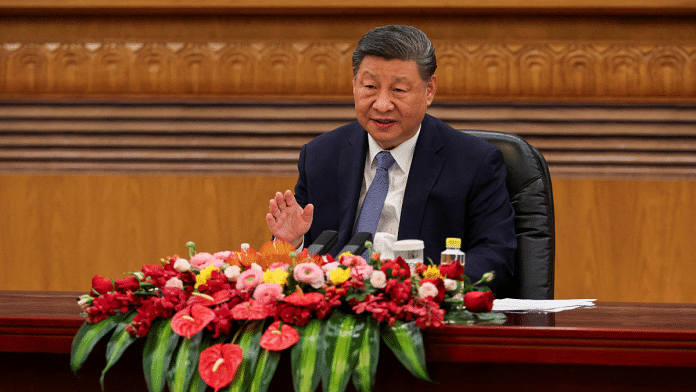But even as Trump declared triumph, the real diplomatic suspense was unfolding elsewhere. In Beijing, a different kind of consternation took hold. China considers the Indian subcontinent not merely a neighbourhood but a strategic sphere, a region to be controlled from Beijing. When India’s decisive retaliation made things unbearable for Pakistan’s military machine, Islamabad had no choice but to sue for peace. In a telling move, it reached out first to Washington instead of its so-called so-called “iron brother” China – an act that not only revealed its desperation but also delivered a stinging geopolitical slight to Beijing.
In response, China moved with the speed and calculation of a power accustomed to orchestrating events from the shadows. Within hours, Beijing mobilised its instruments of statecraft: ministerial calls, press briefings, and strategic insinuations. It subtly yet unmistakably laid claim to the ceasefire, hinting that it, not Washington, had stabilised the region. In this diplomatic shadow play, the truth was less important than the perception. For authoritarian governments, particularly those animated by civilisational ambitions, narratives are instruments of projecting power.
Let’s not forget – it was Pakistan that violated the US-mediated ceasefire almost immediately after agreeing to it, once again proving the hollowness of its commitments and its habitual disregard for peace. Yet, it’s telling that the drone incursions into Indian airspace ceased only after China carefully worded statements. Coincidence? Certainly not. This was a deliberate move, not just to salvage Pakistan’s military credibility, but to reassert Chinese influence as India steadily began to dominate the narrative.
Beijing’s message was as calculated as it was insidious: India, it implied, is merely part of a regional squabble with Pakistan, while China positions itself as a global power above the fray. Under the guise of neutral mediation, China sought to impose a false equivalence – reducing a responsible democracy like India to the level of a reckless, terror-sponsoring state like Pakistan. By cloaking its interference in calls for ‘restraint’, Beijing wasn’t promoting peace; it was projecting dominance. This was less diplomacy and more condescension – a thinly veiled attempt to assert tutelage over India and reframe the regional hierarchy on its terms. In doing so, China not only revealed its strategic insecurities but also its intent to stifle India’s rise by reinforcing a parity that simply does not exist.
In Beijing’s imperial vision, the India-Pakistan theatre is not a bilateral affair between two countries, but rather a sandbox for China’s peacekeeping pretensions. India is thus diplomatically diminished – painted as a mere regional player mired in local squabbles, while China rises, ostensibly, as a magnanimous global stabiliser. This is the crux of China’s strategy: to club India with Pakistan, to perpetuate a diplomatic equivalence that dilutes India’s global standing. Where India aspires toward parity with China on the global stage, China endeavours to relegate India to the sub-continental chessboard. This isn’t peacemaking—it’s posturing. It is a manoeuvre drawn not from Marx or Mao, but from Machiavelli – not ideological, but coldly hierarchical.
Meanwhile, Pakistan, in keeping with its well-worn playbook of duplicity, shamelessly courted both patrons. To Washington, it parroted hollow rhetoric about peace; to Beijing, it pledged loyalty and deference. Pakistan thrives on playing power brokers against each other, not out of strength, but out of chronic instability and desperation. For both the United States and China, Pakistan isn’t a partner—it’s a pawn: a fragile, perpetually mismanaged state that remains geopolitically relevant only because it can be manipulated. Its value lies not in what it brings to the table, but in how easily it can be used – whether to check India or to serve as a proxy in great power games.
For New Delhi, there is an unambiguous lesson as it finds itself navigating between an inattentive ally and a predatory neighbour. The lesson, if not already apparent, should now be etched into every strategic calculation New Delhi undertakes: India must harbour no illusions about the durability or clarity of “global partnerships” when it comes to Pakistan.
The West will always be tempted by the mirage of quick fixes and superficial stability, even if it comes at the cost of India’s security and dignity. China, meanwhile, will always see Pakistan as its Trojan horse in the subcontinent, a convenient disruptor that allows Beijing to play firefighter after fuelling the blaze. For China, Pakistan is not a problem at all – it is an instrument, a conduit for influence, a state useful precisely because of its instability.
In the great game of the 21st century, it is not the clash of civilisations that defines the epoch, but the convergence of interests masquerading as rivalries. Donald Trump and Xi Jinping may appear adversaries on the global stage, but in the Indian subcontinent, their actions converge. Both will come to Pakistan’s rescue – one for strategic expediency, the other for hegemonic design.
Yet, this convergence is not cause for despair. It is, rather, a call to clarity – a demand for India to internalise the lonely truth of its geography and the duplicity of great powers. India must not react emotionally but act strategically. It must focus instead on building autonomous capabilities – in defence, in diplomacy, and in narrative. It must speak with a voice that is sovereign and firm, refusing the terms set by others, particularly the attempt to define it as a peer to Pakistan or a regional footnote to China’s ascent.
There is a lesson here distilled with grim clarity: geography burdens, but it does not condemn. What condemns is strategic complacency. That is the challenge for India: to act with strategic maturity, remain true to itself, and refuse both the bait and the narrative traps set by others.
(Edited by Zoya Bhatti)








